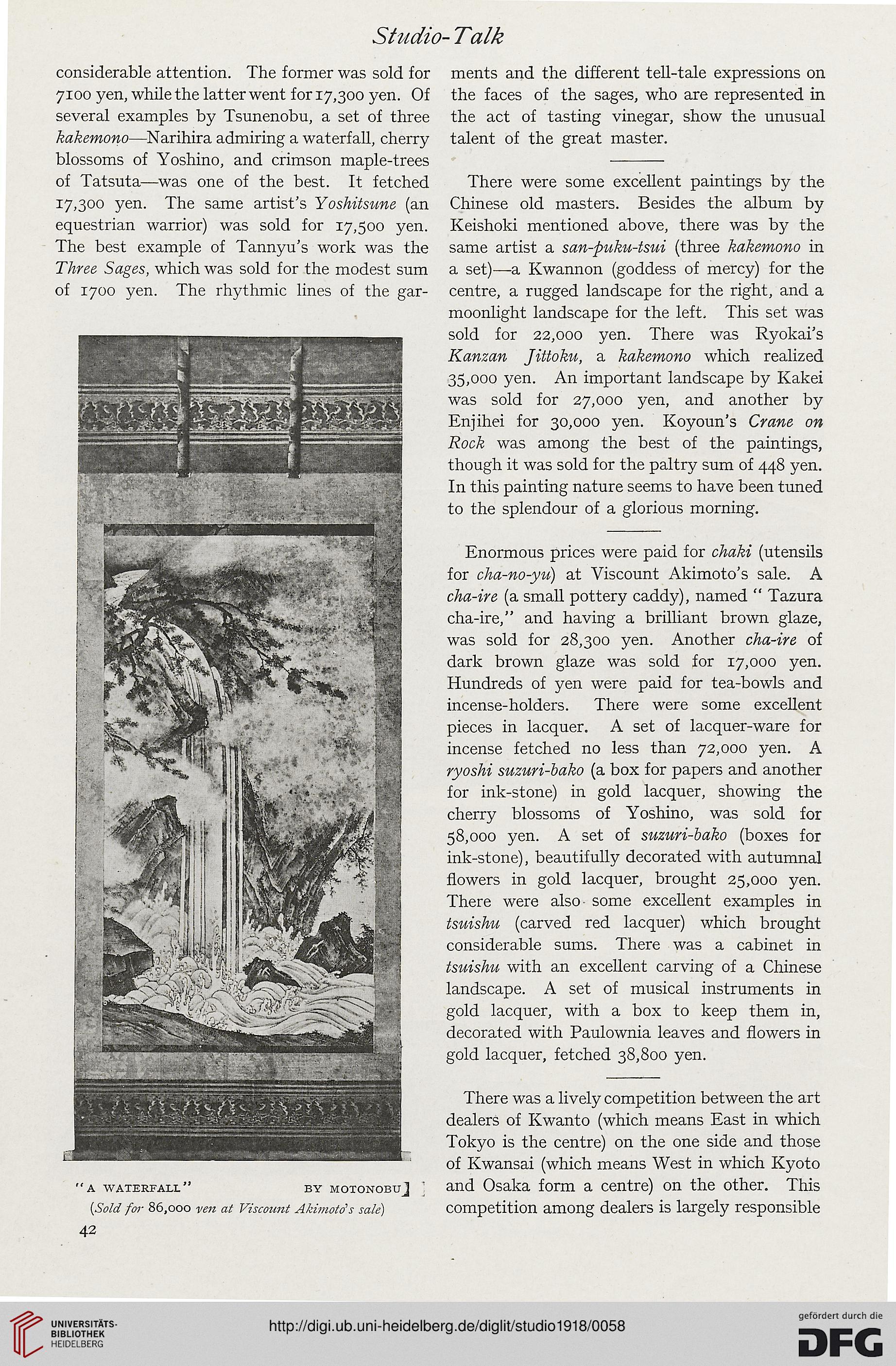Studio-Talk
considerable attention. The former was sold for
7100 yen, while the latter went for 17,300 yen. Of
several examples by Tsunenobu, a set of three
kakemono—Narihira admiring a waterfall, cherry
blossoms of Yoshino, and crimson maple-trees
of Tatsuta—was one of the best. It fetched
r7,30° yen. The same artist’s Yoshitsune (an
equestrian warrior) was sold for 17,500 yen.
The best example of Tannyu’s work was the
Three Sages, which was sold for the modest sum
of 1700 yen. The rhythmic lines of the gar-
" A. WATERFALL” BY MOTONOBUj
(Sold for 86,000 yen at Viscount Akimoto’s sale)
42
ments and the different tell-tale expressions on
the faces of the sages, who are represented in
the act of tasting vinegar, show the unusual
talent of the great master.
There were some excellent paintings by the
Chinese old masters. Besides the album by
Keishoki mentioned above, there was by the
same artist a san-puku-tsui (three kakemono in
a set)—a Kwannon (goddess of mercy) for the
centre, a rugged landscape for the right, and a
moonlight landscape for the left. This set was
sold for 22,000 yen. There was Ryokai’s
Kanzan Jittoku, a kakemono which realized
35,000 yen. An important landscape by Kakei
was sold for 27,000 yen, and another by
Enjihei for 30,000 yen. Koyoun’s Crane on
Rock was among the best of the paintings,
though it was sold for the paltry sum of 448 yen.
In this painting nature seems to have been tuned
to the splendour of a glorious morning.
Enormous prices were paid for chaki (utensils
for cha-no-yu) at Viscount Akimoto’s sale. A
cha-ire (a small pottery caddy), named “ Tazura
cha-ire,” and having a brilliant brown glaze,
was sold for 28,300 yen. Another cha-ire of
dark brown glaze was sold for 17,000 yen.
Hundreds of yen were paid for tea-bowls and
incense-holders. There were some excellent
pieces in lacquer. A set of lacquer-ware for
incense fetched no less than 72,000 yen. A
ryoshi suzuri-bako (a box for papers and another
for ink-stone) in gold lacquer, showing the
cherry blossoms of Yoshino, was sold for
58,000 yen. A set of suzuri-bako (boxes for
ink-stone), beautifully decorated with autumnal
flowers in gold lacquer, brought 25,000 yen.
There were also- some excellent examples in
tsuishu (carved red lacquer) which brought
considerable sums. There was a cabinet in
tsuishu with an excellent carving of a Chinese
landscape. A set of musical instruments in
gold lacquer, with a box to keep them in,
decorated with Paulownia leaves and flowers in
gold lacquer, fetched 38,800 yen.
There was a lively competition between the art
dealers of Kwanto (which means East in which
Tokyo is the centre) on the one side and those
of Kwansai (which means West in which Kyoto
and Osaka form a centre) on the other. This
competition among dealers is largely responsible
considerable attention. The former was sold for
7100 yen, while the latter went for 17,300 yen. Of
several examples by Tsunenobu, a set of three
kakemono—Narihira admiring a waterfall, cherry
blossoms of Yoshino, and crimson maple-trees
of Tatsuta—was one of the best. It fetched
r7,30° yen. The same artist’s Yoshitsune (an
equestrian warrior) was sold for 17,500 yen.
The best example of Tannyu’s work was the
Three Sages, which was sold for the modest sum
of 1700 yen. The rhythmic lines of the gar-
" A. WATERFALL” BY MOTONOBUj
(Sold for 86,000 yen at Viscount Akimoto’s sale)
42
ments and the different tell-tale expressions on
the faces of the sages, who are represented in
the act of tasting vinegar, show the unusual
talent of the great master.
There were some excellent paintings by the
Chinese old masters. Besides the album by
Keishoki mentioned above, there was by the
same artist a san-puku-tsui (three kakemono in
a set)—a Kwannon (goddess of mercy) for the
centre, a rugged landscape for the right, and a
moonlight landscape for the left. This set was
sold for 22,000 yen. There was Ryokai’s
Kanzan Jittoku, a kakemono which realized
35,000 yen. An important landscape by Kakei
was sold for 27,000 yen, and another by
Enjihei for 30,000 yen. Koyoun’s Crane on
Rock was among the best of the paintings,
though it was sold for the paltry sum of 448 yen.
In this painting nature seems to have been tuned
to the splendour of a glorious morning.
Enormous prices were paid for chaki (utensils
for cha-no-yu) at Viscount Akimoto’s sale. A
cha-ire (a small pottery caddy), named “ Tazura
cha-ire,” and having a brilliant brown glaze,
was sold for 28,300 yen. Another cha-ire of
dark brown glaze was sold for 17,000 yen.
Hundreds of yen were paid for tea-bowls and
incense-holders. There were some excellent
pieces in lacquer. A set of lacquer-ware for
incense fetched no less than 72,000 yen. A
ryoshi suzuri-bako (a box for papers and another
for ink-stone) in gold lacquer, showing the
cherry blossoms of Yoshino, was sold for
58,000 yen. A set of suzuri-bako (boxes for
ink-stone), beautifully decorated with autumnal
flowers in gold lacquer, brought 25,000 yen.
There were also- some excellent examples in
tsuishu (carved red lacquer) which brought
considerable sums. There was a cabinet in
tsuishu with an excellent carving of a Chinese
landscape. A set of musical instruments in
gold lacquer, with a box to keep them in,
decorated with Paulownia leaves and flowers in
gold lacquer, fetched 38,800 yen.
There was a lively competition between the art
dealers of Kwanto (which means East in which
Tokyo is the centre) on the one side and those
of Kwansai (which means West in which Kyoto
and Osaka form a centre) on the other. This
competition among dealers is largely responsible




